#rspb minsmere
Explore tagged Tumblr posts
Text
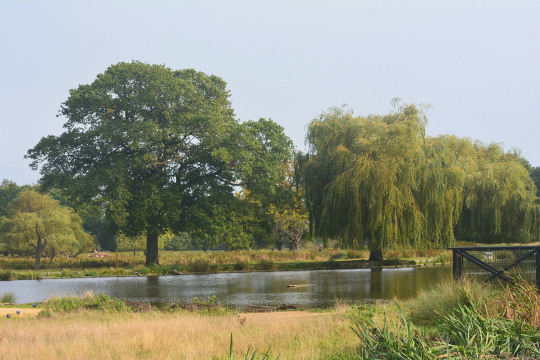

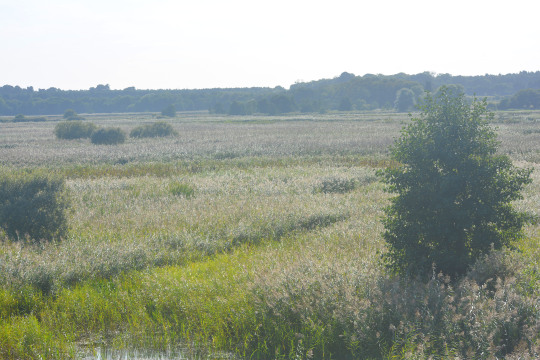

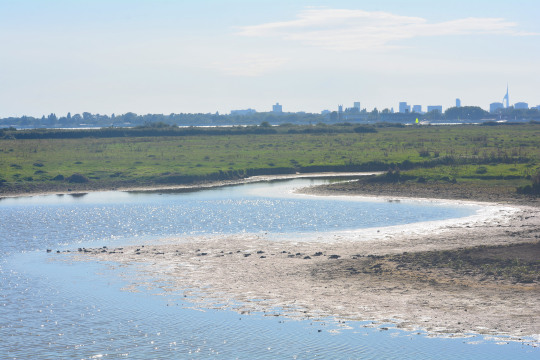



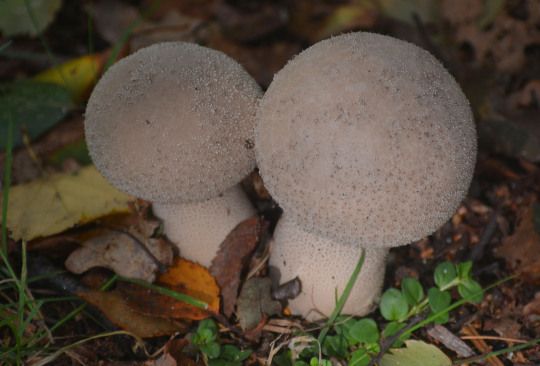
Nine of my favourite landscape and fungi photos I took in September 2023 of; Bushy Park, Thursley in Surrey, RSPB Minsmere in Suffolk, Keyhaven in Hampshire, Farlington Marshes in Hampshire, Old Winchester Hill in the South Downs, Lakeside Country Park in Hampshire, devil's fingers at Bolton's Bench in the New Forest and common puffballs on Brownsea Island, Dorset. It was a pleasure to take in many stunning and very varied vistas this month from woodland to coast in some great bits of weather, with the sweet September sunlight providing some lovely conditions. I enjoyed moons and sunsets from home this month too. As we progress into autumn it was nice to see some colourful leaves and it was great to see more fungi about. My last post featured some of my key wildlife photos and moments this month.
#fungi#landscapes#landscape#devil's fingers#bolton's bench#new forest#brownsea island#common puffball#dorset#hampshire#suffolk#london#surrey#south downs#rspb minsmere#thursley common#thursley#lymington-keyhaven nature reserve#lakeside country park#old winchester hill#september#2023#autumn#summer#mushrooms#europe#outdoors#views
3 notes
·
View notes
Text
Day Five









A much needed rest day has got the feet well on tue mend and the knees a little more recovered, ap pd course it's been another 70km ridden today!
The campsite at Shottisham is idyllic and I will have to return sometime, could easily spend a week there taking on the footpaths and beautiful scenery.
But on we go! First a long ride around River Alde before rolling down to the seaside town of Thorpness. I have a lot of childhood memories of this area so it was great to be nacl and see the House In The Clouds and the boating lake.
Then a bit further along to take in Sizewell where we used to go swimming and dodge the jellyfish, and a quick look at the nuclear power station which I had a small obsession about as a kid.
A late lunch/early dinner in the beautiful surroundings of RSPB Minsmere, then on up the road to Bluthburg to cross the river Blyth.
Unfortunately some time on the A roads can't be avoided, but made reasonable time down to Southwold to resupply.
And with that done, time to find some rest for the night!
2 notes
·
View notes
Text
Photo of the Week: 24-30 June 2024
New Post has been published on https://petn.ws/HGBoH
Photo of the Week: 24-30 June 2024
This pin-sharp shot of two tussling male Western Marsh Harriers by Simon Richardson was this week’s standout photo. With talons clasped together and piercing stare on the right-hand bird, it’s clear that these birds mean business as they confront each other, presumably over territory. Taken at the hot-spot of Minsmere RSPB in Suffolk, Simon has […]
See full article at https://petn.ws/HGBoH #BirdNews
0 notes
Text
rspb dearne valley - old moor
RSPB Old Moor is an oasis for wildlife and a visitor haven with easy access from the M1 and A1. The reserve has strategically placed viewing hides and open vistas over the wetland habitats. As a visitor haven nature reserve, Old Moor has a top-rated family offering with wild play areas, activities and trails to help you and your loved-ones connect with nature.
youtube
Highlights and key moments
In 1889, Emily Williamson created the Society for the Protection of Birds with one core aim – to fight a fashion for feathers and exotic plumes that were driving birds including little egrets, great crested grebes and birds of paradise towards extinction. Her all-women movement was born out of frustration that the male-only British Ornithologists Union was not acting on the issue.
Saving wildlife
Emily’s efforts soon gathered pace and after joining forces with Etta Lemon and Eliza Phillps, the movement grew in popularity and influence. So much so, that in 1904 the society was awarded a Royal Charter, making it the Royal Society for the Protection of Birds. Eventually, the 1921 Importation of Plumage (Prohibition) Act was passed, marking the RSPB’s first successful campaign for nature.
Protecting places for nature
Conservation has always been central to the RSPB and in 1930 the society bought its first nature reserve. In 1947, Minsmere was made a reserve and avocets – once extinct in the UK – bred at both Minsmere and the nearby Havergate Island. More reserves followed, and the RSPB now manages over 200 nature reserves across the UK.
People power
In 1965, the RSPB launched the Young Ornithologists Club (now known as the Wildlife Explorers) for young people, and in 1979, with a special slot on kid’s TV show Blue Peter, launched the Big Garden Birdwatch. This annual event to count garden birds is now the world’s largest citizen science project and provides a valuable snapshot to our birdlife is faring.
A global force to save nature
The early 90s saw the RSPB consolidate its international efforts and in 1993, the society became a Partner of BirdLife International, the global partnership formed to join bird and conservation organisations worldwide. By 1997 RSPB membership passed over one million members and we are now the largest nature conservation charity in Europe.
Together with our members and supporters, the RSPB continues to work with the same determination and passion to save nature as that of our founders over 100 years ago.
youtube
Our Timeline
1889 - 1899
1889 February: formation of the embryonic Society in Didsbury. Emily Williamson Hon Secretary until May 1891.
1891 The Didsbury group and ladies attending Eliza Phillips' Fur and Feather meetings at her house in Croydon amalgamate to become the Society for the Protection of Birds.
June: Duchess of Portland accepts the office of president and remains so until her death in 1954.
October: First report of the society. Society's first publications - two pamphlets and three leaflets, including one by W H Hudson entitled The Osprey, or Egrets and Aigrettes. Leaflet no 1 = Destruction of Ornamental Plumaged Birds.
1892 Constitution adopted. Margaretta Lemon (universally known as Mrs Lemon, married to Frank Lemon) appointed Hon Secretary. 1894 W H Hudson elected Chairman of Committee (i.e. council).
1895 Montagu Sharpe (later Sir Montagu) elected Chairman of Committee and remains so until 1942.
1897 First office established in London, at 326 High Holborn in the offices of Witherby & Sons, publishers - the Hon Sec and a paid assistant secretary work from here.
1898 June: Office moves to 3 Hanover Square, rented from the London Zoological Society. First Society Christmas cards produced - some 4,500 cards are sold.
1899 September: Queen Victoria confirms an order which certain regiments should discontinue wearing 'osprey' plumes.
1900 - 1904
1900 First legacy received - £25.
1901 Society gives prizes for essays suggesting the best way of establishing Bird and Tree Day (ie the start of the schools educational programme). First watcher appointed, to protect breeding pintails at Loch Leven, Scotland.
1902 Bird and Tree Scheme initiated - continues until 1964. Watchers' Fund started.
1903 April First issue of Bird Notes and News, the first regular publication for members. Society's first postcards appear featuring various species of bird.
1904 3 November Incorporated by Royal Charter - now The Royal Society for the Protection of Birds. Frank Lemon appointed Hon Secretary. Membership subscription set at one guinea for fellows, five shillings for members.
1905 - 1929
1905 Watchers' Committee established.
1906 RSPB sells its first nestboxes.
1908 Importation of Plumage (Prohibition) Bill introduced to Parliament (but not passed until 1921).
Inspector appointed by RSPB to investigate caged bird trade.
1909 Office moves to 23 Queen Anne's Gate.
1913 Perches on lighthouses installed.
1922 Importation of Plumage (Prohibition) Act, passed in 1921, comes into force on 1 April, the culmination of the RSPB's original raison d'être. W H Hudson dies on 18 August, naming the society as a high residuary legatee.
1923 April Offices move to 82 Victoria Street.
1930 - 1939
1930 The purchase of Cheyne Court, Romney Marsh, announced, the RSPB's first nature reserve. The first land bought was an 18-acre meadow in 1928. The whole reserve was sold in 1950, because drainage of surrounding land had caused it to lose its original attraction for birds.
1931 RSPB prosecutes an oil company for allowing oil to escape from their vessel near Skokholm off the Welsh coast - fined £25.
Wild Birds Protection Legislation (N Ireland)
1932 Dungeness and East Wood reserves announced (though land obtained at both in 1930) - the RSPB's oldest extant nature reserves.
1933 Protection of Birds Act passed, concerning trade in and taking of wild birds for aviculture. Came into force 17 May 1934.
1936 R Preston Donaldson appointed secretary.
youtube
2017- 2019
2017 The Albatross Task Force has been so successful that black-browed albatross has recently been downgraded to ‘Least Concern’. Argentina has announced new measures to introduce bird-scaring ‘Tori lines’, which are predicted to save 9,000 albatross lives a year. We helped launch NFFN: “The Nature-Friendly Farming Network has launched and will provide a platform for farmers to use their voices to advocate for farming that works for people and wildlife. Farmers have come together to demonstrate what they do for wildlife, whilst still producing plentiful quality produce by building markets for nature-friendly farming products. The members are committed to secure farming policies that support wildlife, sustainable agriculture and fairness for farmers." The ‘Puffarazzi’ project brought in more than 1,400 pictures of puffins from 602 people over 39 sites across UK and Ireland. Tracking 22 and 11 puffins respectively on the islands of Shiants and Unst also revealed foraging patterns for the species. In Sierra Leone, $1.8 million has been secured from the West Africa Biodiversity and Climate Change Programme to scale up conservation work across the 350,000 hectares of the Greater Gola forest landscape. At the same time, we have worked with 1,500 farmers to produce rainforest friendly cocoa, with 12 metric tonnes exported and the first trial RSPB Gola chocolate bars produced. Target species favoured by the conservation methods are the white-necked picathartes and the pygmy hippopotamus. Our vulture programme in Nepal is celebrating a major milestone as six captive-reared, Critically Endangered, white-rumped vultures have been released into the wild after 7 years in captivity. This exciting news followed the thankful end in this region of diclofenac sales for veterinary purposes and a partial recovery of the wild population of the species. In September, we reached a major milestone in our battle to save Lodge Hill, the most important site for nightingales in the UK. The planning application for 5,000 houses was withdrawn, with more than 10,000 people objecting to the application to build on this incredibly important SSSI. 2018 The Shiants are declared rat-free after a partnership project to eradicate invasive rodents. The first storm petrel chick is heard calling on the islands. Thanks to the efforts of the RSPB Investigations team and Sovereign Base Area Police, illegal bird trapping on the UK Base in Cyprus falls by 70%. First bittern heard booming on the Isle of Wight - at RSPB Brading Marshes. Nightjars breed at The Lodge for the first time in 45 years. The Wallasea Wild Coast project in Essex is completed. Sherwood Forest now managed by an RSPB-led group, new visitor centre opens. One hundred years since white-tailed eagles were lost from the UK, there are now more than 100 pairs breeding in Scotland. The first WTE chicks on Orkney for 145 years successfully fledge on Hoy.
2019 RSPB marks its 130 year anniversary! In a historic first, the RSPB purchased land in a UK Overseas Territory, ten acres of tropical rainforest in the Cayman Islands, home to Grand Cayman blue iguana. Best ever year for bitterns in recent times, with over 100 male bitterns recorded on RSPB nature reserves. RSPB Cymru helped launch the Celtic Rainforests Wales LIFE project to restore, protect and enhance the ancient Welsh woodlands. The RSPB released a single of pure birdsong, Let Nature Sing. It reached number 18 in the UK music charts. Together with over 70 other organisations, the RSPB launched the State of Nature 2019 report, a detailed analysis of the status of UK species.
2020 - Present
2020 From March, the global coronavirus pandemic forced national lockdowns and widespread hardships. The RSPB launched a weekly email Notes on Natures for supporters and to share news about nature. This now reaches over one million people. Many people turned to nature during lockdown and the RSPB experienced an uplift in the number of people sharing sightings of birds and wildlife. The RSPB launched online events to share in the joy of nature during lockdown – including the Breakfast Birdwatch and Dawn Chorus Day. Record-breaking year for UK’s rarest seabirds, roseate terns, with 130 breeding pairs recorded on Coquet Island. Twenty-year anniversary of nature friendly farming at RSPB Hope Farm was hailed a success as wildlife numbers soared. UK Overseas Territory of Tristan da Cunha became one of the world’s biggest sanctuaries for wildlife thanks to joint efforts of the RSPB, local people and partners. Crane numbers hit a record high of over 200 birds after becoming extinct in the UK nearly 400 years ago.
2021 The RSPB recorded the largest Big Garden Birdwatch ever, with over one million people taking part. Golden eagles breed again in Orkney after an absence of almost 40 years
0 notes
Text
Birdwatching in the UK - Discover Rare Birds with the RSPB
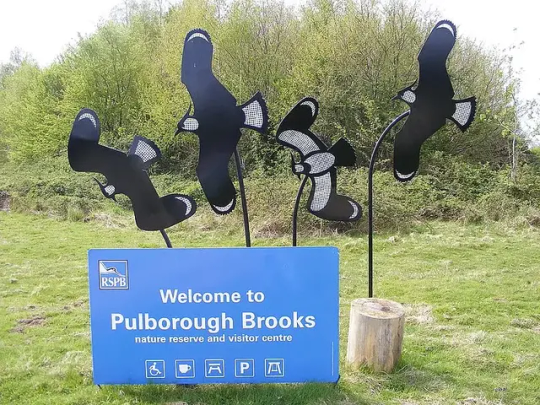
The Growing Popularity of Birdwatching in the UK
Birdwatching has become a popular activity for many people in the UK, and it's no surprise why. With its abundance of natural habitats and diverse bird species, the country offers an ideal environment to enjoy this pastime. The Royal Society for the Protection of Birds (RSPB) is one organization that has been instrumental in promoting birdwatching across the UK.
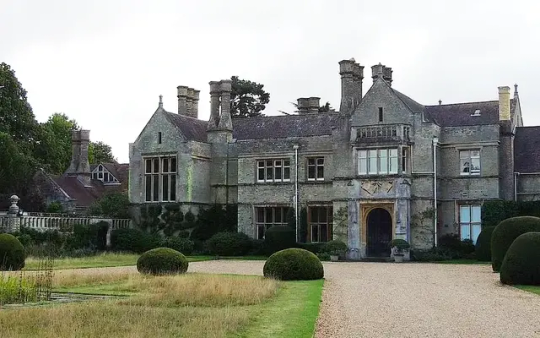
The Lodge, Sandy, Bedfordshire. Headquaters of the RSPB. Photo by Orangeaurochs. Flickr.
The RSPB and its Mission
The Royal Society for the Protection of Birds is a UK-based charitable organization that was founded in 1889. Its primary mission is to promote and protect the welfare of wild birds and their habitats. It has grown into one of the largest wildlife conservation charities in Europe, with over 1.2 million members and supporters. Milestones in RSPB's History One of the key milestones in the history of RSPB was its successful campaign to ban the use of DDT, a toxic pesticide that led to a decline in bird populations during the mid-20th century. The RSPB's efforts prompted governments around the world to take action against DDT and other harmful chemicals, leading to significant improvements in bird populations across many regions.

Starling Murmuration - RSPB Minsmere. Photo by Airwolfhound. Flickr.
Top Birdwatching Locations in the UK
Are you an avid birdwatcher? Then you're in luck! The RSPB offers a multitude of stunning birdwatching locations throughout the UK. Here are some of the best: 1. Minsmere: Located on the Suffolk coast, this reserve is home to over 100 breeding species and a variety of habitats such as reedbeds, woodland, and heathland. 2. Bempton Cliffs: Situated on the Yorkshire coast, this reserve boasts breath taking views of thousands of seabirds including puffins, gannets and kittiwakes. 3. Loch Garten: In Scotland's Cairngorms National Park lies this tranquil location known for its impressive highland scenery and resident ospreys which can be seen fishing in summer months. 4. Anglesey, Wales: There are several RSPB sites but the stand out one is the South Stack Cliffs Nature Reserve: boasting a home to over 4,000 species, including guillemots, puffins, choughs, and razorbills. 5. The Cairngorms, Scotland: Explore the Cairngorms and discover a range of rare and majestic wildlife including birds of prey. Keep an eye out for elusive creatures like the ptarmigan, siskin, and grey-footed woodpecker. And if you're lucky, you might even catch a glimpse of the UK's largest grouse species, the capercaillie.
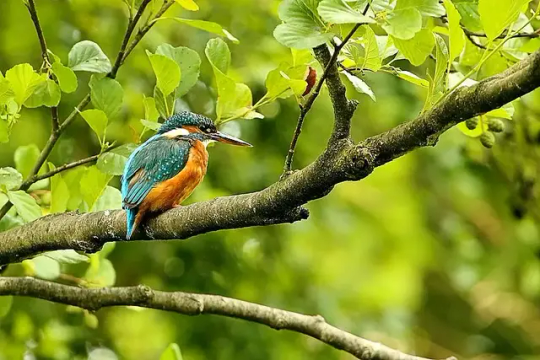
Kingfisher - RSPB Fowlmere. Photo by Airwolfhound. Flickr.
Bird species to look out for at RSPB sites
The Royal Society for the Protection of Birds has identified several bird species that visitors to their sites in the UK should keep an eye out for. These birds are not only beautiful to look at but also play a vital role in maintaining the delicate balance of our ecosystems. One such bird is the kingfisher, which can be found near water sources such as rivers and lakes. With its distinctive blue and orange plumage, it is easily recognisable and a joy to watch as it dives into the water to catch fish. Another bird species worth keeping an eye out for is the puffin, which can be spotted at RSPB Bempton Cliffs in Yorkshire during breeding season. Their strikingly colourful beaks make them instantly recognisable and they are a favourite among birdwatchers.

Entrance Lodge, RSPB reserve, Sandy. Photo by Martyn Johnson. Wikimedia.
Getting Involved with the RSPB
The Royal Society for the Protection of Birds is a UK-based charity that works to protect birds and their habitats. If you're interested in getting involved with this important conservation work, there are several ways to do so. One option is to become a member of the RSPB. Membership Benefits Membership benefits include receiving a quarterly magazine, free entry to over 170 nature reserves across the UK, and discounts on bird food and accessories. The membership also includes a welcome pack and a free gift for each new adult member. Events and Volunteering Another way to get involved with the RSPB is by attending one of their many events. The organization hosts talks, walks, and other activities that allow members of the public to learn more about birds and conservation efforts in general. Additionally, volunteering with the RSPB can be an incredibly rewarding experience for those who want to make a hands-on difference in bird protection efforts.

A colony of puffins. Photo by Joxean Koret. Flickr.
Benefits of Birdwatching for Mental and Physical Health
Birdwatching has always been a popular hobby in the UK, and for good reason. Not only is it a great way to enjoy the outdoors, but it also comes with numerous mental and physical health benefits. The Royal Society for the Protection of Birds reports that birdwatching can help reduce stress levels, improve our mood and even boost our immune system. Studies have shown that spending time outdoors surrounded by nature can have a significant impact on our mental health and birdwatching is an excellent way to incorporate this into your life. It allows us to disconnect from the stresses of daily life and be present in the moment, focusing on the beauty of these fascinating creatures. Watching birds can give us a sense of calmness and serenity, which promotes relaxation and reduces anxiety levels. In addition to its positive effects on our mental wellbeing, birdwatching encourages people to walk outdoors and this provides numerous physical benefits.

red-breasted nuthatch. Photo by Matt MacGillivray. Flickr.
Embracing Birdwatching with the RSPB
In conclusion, birdwatching has become an increasingly popular hobby in the UK and offers a great way to connect with nature. The Royal Society for the Protection of Birds is one of the leading organizations in the UK dedicated to conserving birds and their habitats. By joining this organization as a member, you not only support their conservation efforts but also gain access to expert advice on birdwatching and to their sites. Birdwatching can be enjoyed from anywhere, whether it's from your own backyard or out in nature reserves. With over 600 species of birds found in the UK, there's always something new to discover. Observing these fascinating creatures can help us appreciate the diversity of life around us and develop a deeper understanding of our environment. So why not give birdwatching a try? Whether you're just starting out or have years of experience, RSPB provides resources and guidance for all levels. Sources: THX News, Wonderlust & RSPB. Read the full article
#Birdconservationefforts#Birdwatchingevents#BirdwatchingintheUK#GettinginvolvedwithRSPB#JoinRSPBmembership#Mentalhealthbenefits#Physicalhealthadvantages#RSPBorganization#Topbirdwatchinglocations#UKbirdspecies
0 notes
Link
Wikipedia article of the day is RSPB Minsmere. Check it out: https://ift.tt/2jXHHgM
1 note
·
View note
Text
Wikipedia article of the day for December 5, 2018 -- RSPB Minsmere
The Wikipedia article of the day for December 5, 2018 is RSPB Minsmere. RSPB Minsmere is a nature reserve owned and managed by the Royal Society for the Protection of Birds at Minsmere, Suffolk, England, since 1947. The 1,000-hectare (2,500-acre) site covers areas of reed bed, lowland heath, acid grassland, wet grassland, woodland and shingle vegetation. It is conserved as a Site of Special Scientific Interest, Special Area of Conservation, Special Protection Area and Ramsar site. It supports bird species such as the bittern, stone-curlew, marsh harrier, nightjar and nightingale, as well as a wide variety of other animals and plants. The Minsmere marshes were the site of a medieval abbey and a Tudor artillery battery. Reclaimed as farmland in the 19th century, they were re-flooded during World War II to protect against possible invasion. The reserve has a visitor centre and eight bird hides. Potential threats to the site include coastal erosion and flooding or salination as climate change causes rising sea levels.
1 note
·
View note
Text
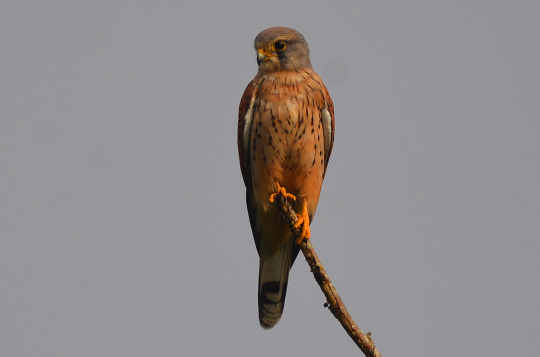


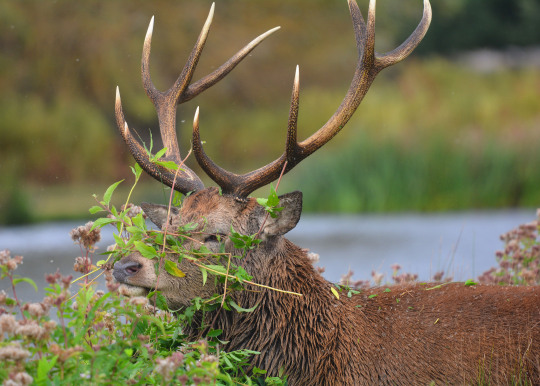
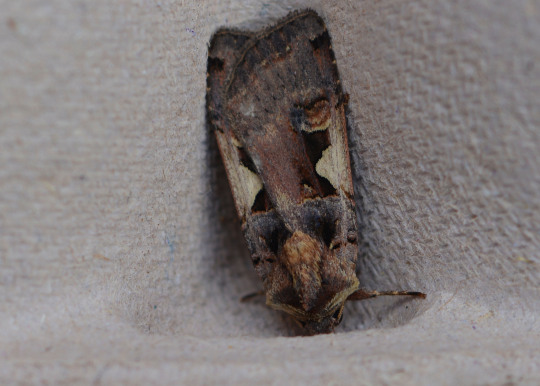
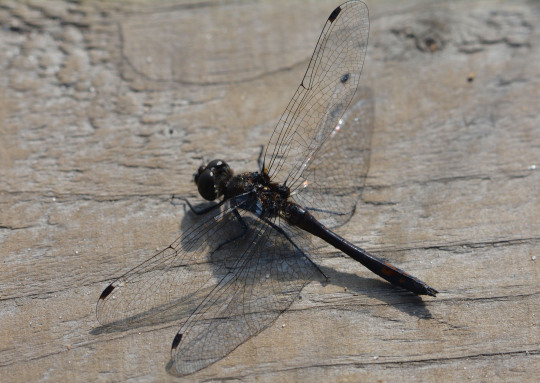
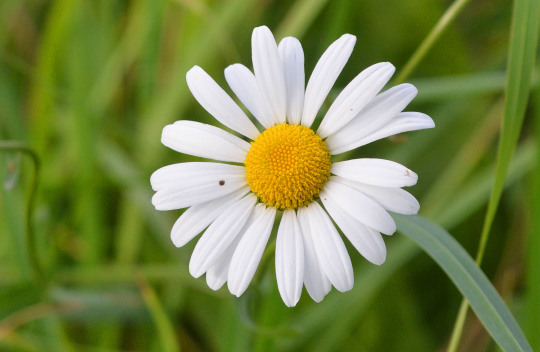
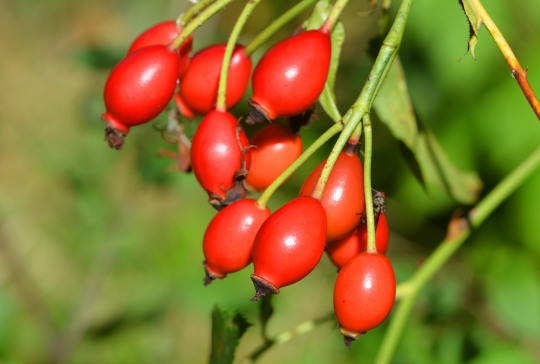
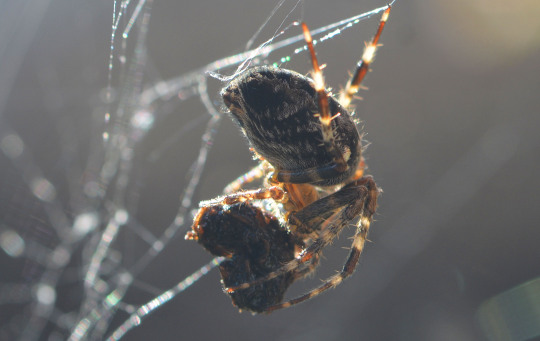
Nine of my favourite flora and fauna photos I took in September 2023 and month summary
The photos are of; Kestrel at Lakeside Country Park, Clouded Yellow at Old Winchester Hill, Osprey from a boat trip around Poole Harbour with Birds of Poole Harbour, Red Deer at Bushy Park, Setaceous Hebrew Character at home, Black Darter at Thursley Common, oxeye daisy and rose hips at Lakeside and spider with prey in the front garden.
As hoped in the midst of bird migration, changing times in the year and with this past week off work to pack with big trips September was a super and packed wildlife watching and photography month for me with so much seen and many places visited. For birdwatching migration was the theme of the month again as I picked up birds I needed Yellow Wagtail and Little Stint with a few seen for my year list, seeing the Red-necked Phalarope a week ago Pennington brought in by a storm was a massive bonus as a top species for my birding year and Monday's Minsmere trip paid off to allow us to see one we wanted to a Bittern. It's surely been my finest year of Ospreys with the amount I've seen and September contained much of the string of late summer/autumn sightings in the south which has been a phenomenal run for me. Other standout birds for me this month have of course been those two White-tailed Eagles seen on the boat trip too, Marsh Harrier, Peregrine, Hobby, a fair few Avocets, Ruffs and Curlew Sandpipers such fine and gorgeous waders in a strong wader month, Spoonbill and a smartly marked and colourful duck quartet of many Teals and Gadwall and Wigeon and Shoveler. Great Crested Grebe, Kingfisher, Great Spotted Woodpecker and Jay alongside Kestrel and Coot were patch highlights at Lakeside this month with Jays enjoyed elsewhere as we get further into autumn.
For butterflies the final piece of my extraordinary 2023 jigsaw was laid when we excitingly saw our first Clouded Yellow of the year on a hot and sunny day at the start of the month at Old Winchester Hill, an exhilarating moment with an exquisite species. Whilst the butterfly season quietened down overall in a month with a fair bit of hot and sunny weather a few species prevailed/re-emerged into my year with great and in places numerous times seeing Small Copper, Small Heath, Meadow Brown, Speckled Wood, Green-veined White, Peacock, Comma and of course Red Admiral this month with me making the most of Chalkhill and Adonis Blue in the Old Winchester Hill visit. For much of the month we did moth traps at weekends, this delve into an activity we hadn't done before allowed us to see many gems such as the Setaceous Hebrew Character, Small Blood-vein, Treble-bar, Garden Carpet, Lesser Broad-bordered Yellow Underwing, Large Yellow Underwing, Light Emerald, the Nutmeg, Vine's Rustic and loads of L-album Wainscots, Willow Beauty and Square-spot Rustics. It was fun doing this and the Snout was a key moth this month that came into the house.
Dragonflies and damselflies did take the baton from butterflies a bit as expected, with many wonderful views of Migrant Hawker, Southern Hawker and Common Darter such key species as the season goes on at a few places and Blue-tailed Damselfly and Common Blue Damselfly. Alluring miniature Black Darters at Thursley were a treat to see on Tuesday with them my first of the year my dragonfly and damselfly year list like my five others this year became my highest ever, and I was thrilled to see Emerald Damselflies again this year at Minsmere and Thursley this week. It was a really good month for areas of nature I'm less familiar with especially spiders with many seen well from orbweavers out the front to a harvestman at Thursley. Hornet, bees, wasp, beetles, ants, crickets and grasshoppers were highlights this month too.
It was a mega mammal month with Red, Fallow, Sika and Muntjac Deer, Red Squirrel and Water Vole massive species of the week off over the past week real big highlights of my wildlife year, and I saw Rabbit, Roe Deer and Grey Squirrel well this month. For flowers the season waned a little but species such as common toadflax, devil's-bit scabious, creeping thistle, wild carrot, pineappleweed, ragwort, water mint, common, musk and marsh mallow and heathers kept me going. Sundew was a blockbuster of my month this week at Thursley. In a bumper year for hawthorn especially I was very much taken by fruits this month enjoying loads of hawthorn and rose hips, blackthorn sloes, guelder rose berries and acorns especially. I also enjoyed seeing seed heads of the likes of carrot, hogweed and ragwort too. Shortly I shall do another post with nine of my favourite landscape and fungi photos I took this month and some thoughts. I hope you all have a good October.
#photography#clouded yellow#old winchester hill#kestrel#lakeside country park#osprey#poole harbour#setaceous hebrew character#eastleigh#black darter#thursley#thursley common#surrey#dorset#hampshire#rspb minsmere#suffolk#red deer#bushy park#london#oxeye daisy#spider#rose hips#september#white-tailed eagle#small copper#migrant hawker#light emerald#europe#england
2 notes
·
View notes
Photo


A gorgeous Eurasian Teal drake and a better-camouflaged Teal duck wading in the shallows at Minsmere RSPB reserve.
There had been heavy rain so most of the lakes were too deep for waders, I just saw a few Lapwings and a couple of Avocets on the edges of the many small islands. But there were hundreds of ducks (Teal, Shovellers, Mallards, Gadwall, Shelducks) including this pair that were only a couple of meters from the hide and looked truly splendid in the sun.
#ducks#cute ducks#teal#common teal#rspb#bird watching#Minsmere#cute birds#duckdaysout#duckfacts#sussex#mallards#gadwall#Shelduck#shoveller duck
5 notes
·
View notes
Text
East Anglian Weekend

View On WordPress
0 notes
Text
Photo of the Week: 24-30 June 2024
New Post has been published on https://petn.ws/vmUth
Photo of the Week: 24-30 June 2024
This pin-sharp shot of two tussling male Western Marsh Harriers by Simon Richardson was this week’s standout photo. With talons clasped together and piercing stare on the right-hand bird, it’s clear that these birds mean business as they confront each other, presumably over territory. Taken at the hot-spot of Minsmere RSPB in Suffolk, Simon has […]
See full article at https://petn.ws/vmUth #BirdNews
0 notes
Text
https://www.theguardian.com/environment/2022/may/02/dartford-warbler-welcomed-near-extinction-rspb
#birds#good news#animals#nature#animal conservation#conservation#dartford warbler#environmentalism#climate hope
62 notes
·
View notes
Text
Birdwatching in East Anglia: Exploring the Rich Avian Diversity and Habitats of the UK
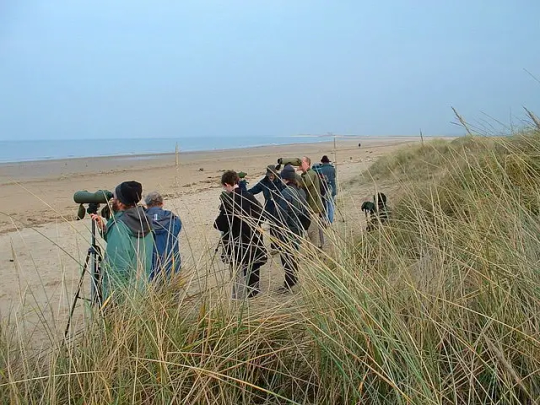
Welcome to the world of bird watching in East Anglia, UK. This region is renowned for its diverse range of bird species and habitats, making it a prime destination for avid bird watchers and nature enthusiasts. East Anglia encompasses the counties of Norfolk, Suffolk, Cambridgeshire, and Essex. It boasts a unique blend of wetland, heathland, woodland and coastal areas that support a wide variety of birds throughout the year. From majestic birds of prey such as the marsh harrier to rare wading birds like the avocet, there is something here for every birding enthusiast.
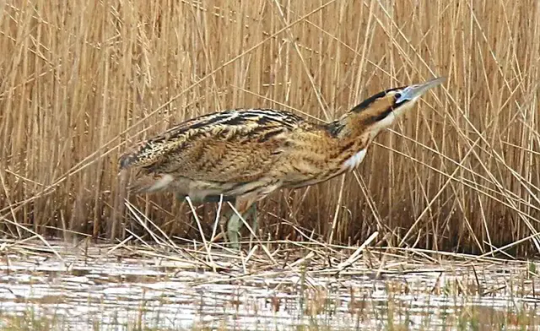
Male Bittern at Secker Hide, NWT Hickling. Photo by Nick Goodrum Photography. Flickr.
When to visit East Anglia
Whether you are an experienced birder or just starting out on your journey into this fascinating hobby, with over 300 species of bird, East Anglia offers plenty to explore and discover and there’s plenty to see whatever the time of year. You can watch winter migrant birds along the coast and the spectacular raptors coming in to roost in the Broads. In the spring, if you get up early, you can hear the dawn chorus in ancient woodlands, and in summer you can observe nesting peregrines on the Norman cathedral right in the heart of Norwich.

Reed Warbler West Canvey Marsh. Photo by Alan Shearman. Flickr.
Inland Habitats in East Anglia
Inland habitats may not always be the first place that comes to mind when thinking about birdwatching, but they are actually home to a surprising variety of avian species. From open fields and grasslands to forests and wetlands, these habitats provide food, shelter, and breeding grounds for many birds. One example of a bird commonly found in inland habitats is the meadowlark. These brightly colored birds are often seen perched on fence posts or soaring over open fields, singing their distinctive songs. Another common resident of inland areas is the red-tailed hawk. These large raptors nest in trees or on cliffs and can often be spotted circling overhead looking for prey.
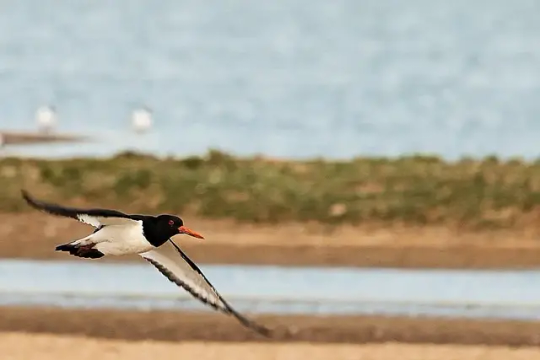
Oystercatcher - RSPB Minsmere. Photo by Airwolfhound. Flickr.
Wetland Habitats
In East Anglia, wetland areas attract avocets and little ringed plovers, both species that love the open islands of young wetlands for breeding. There is suspicion that the beautiful garganey, a migrant duck from Africa, bred in these local wetlands. Winter flocks include wigeon, teal, gadwall, shelduck and great crested grebe, with some of these staying to breed. As the reedbeds grow, reed and sedge warblers begin to move in. You can also find the marsh harrier, bittern and stone curlew in the East Anglia's wetlands alongside birds like kingfishers and geese. Norfolk has a stunning range of bird life, and beautiful nature reserves. Cetti’s warblers sing loudly from rustling reedbeds and moustached bearded tits join the warblers with their pinging call. Norfolk is a birdwatchers’ paradise and a wonderful place for children to begin to learn about their feathered friends. With child-friendly visitor centres and nature reserves, you’ll find all the help and information you need to get started. Wetland environments such as marshes and ponds also attract species such as herons, egrets, ducks, and geese which all rely on these areas for feeding and nesting.
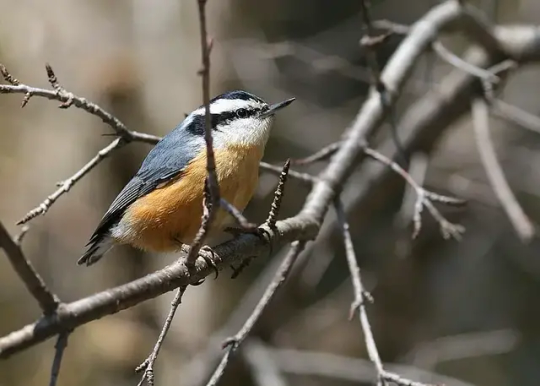
Red-breasted nuthatch. Photo by Matt MacGillivray. Flickr.
Best Birdwatching Spots
East Anglia boasts some of the best birdwatching sites in the UK, attracting both casual and serious birdwatchers from all over the world. If you are planning to visit East Anglia soon, here are some of the many top spots to consider:
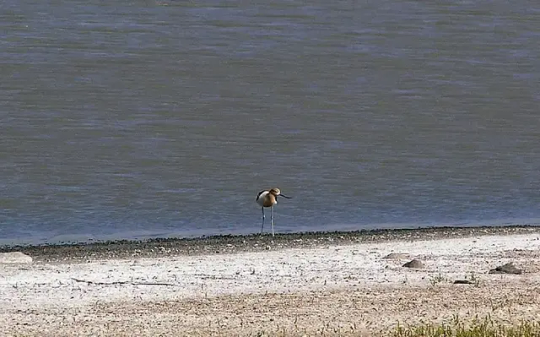
Advocet. Photo by Sipris Swan. Flickr.
Cley Marshes Nature Reserve
One of the most popular places for birdwatching is Cley Marshes Nature Reserve. This reserve is situated on the north coast of Norfolk and stretches across 400 acres of land. It hosts a variety of habitats including reed beds, salt marshes, shingle beaches and freshwater lagoons. These habitats attract different species including avocets, bitterns, marsh harriers and terns.

Pallas's Leaf-Warbler. Photo by Francesco Veronesi. Flickr.
Minsmere RSPB Reserve
Another great location for birdwatching is Minsmere RSPB Reserve which is located on the Suffolk coast near Aldeburgh. One of the most iconic birds in East Anglia is the avocet. These elegant wading birds are easily recognizable by their distinctive upturned bills. They can be found in large numbers at RSPB Minsmere on the Suffolk coast, where they breed during the spring and summer months. Other coastal birds commonly spotted in this region include oystercatchers, redshanks, and dunlins. The widest range of breeding birds in the country call this nature reserve home. If you want to hear the sound of nightingales, come in May, and you can also see the sand martin colony in the old car park.
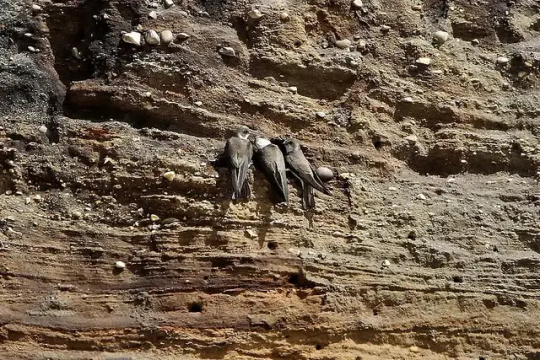
Sand Martins on a cliff face. Photo by Jo Garbutt. Flickr.
Holkham National Nature Reserve
Holkham National Nature Reserve was created in the late 19th century by the 3rd Earl of Leicester who planted pine trees on the dunes, creating a shelter-belt to protect the reclaimed farmland. Today this ribbon of mature woodland still separates the vast expanse of dunes and flat sand from the farmland behind. On the south side of the pine belt the mixture of deciduous trees and bushes provide excellent habitat for yellow browed and pallas’s warbler. It was also the site for Britain’s only red breasted nuthatch, usually found in America. If you visit Holkham on a spring evening you can hear the croaking of natterjacks and at high tide it can be a good place to spot divers, grebes and sea ducks.
Conclusion
East Anglia offers birdwatchers an abundance of opportunities to observe a diverse range of avian species in their natural habitats. From the vast expanses of the Norfolk Broads to the rugged coastline of Suffolk, there is something for everyone. With a little patience and some basic knowledge of bird identification, you can witness everything from rare migrants to resident species that are familiar but no less fascinating. So why not grab your binoculars, head out into the great outdoors, and experience the joy of birdwatching in East Anglia for yourself? You never know what feathered wonders you might discover! Sources: THX News & The Tourist Trail. Read the full article
#AvocetbirdsightingsEastAnglia#BestbirdwatchingspotsUK#BirdidentificationtipsEastAnglia#BirdspeciesinNorfolk#BirdwatchingEastAnglia#BirdwatchinginEssex#CoastalbirdwatchingSuffolk#NorfolkBroadsbirdwatching#RaremigrantsUK#TopbirdinglocationsSuffolk
0 notes
Photo
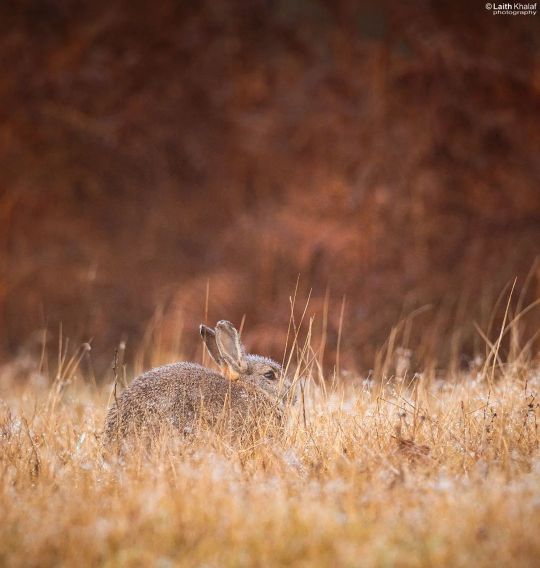
Keeping Still In The Morning Dew. A rabbit sits as still as a statue in the morning dew. I went to RSPB Minsmere for an early shoot and on my way through to my first spot I came across this little beauty trying to hide in the long grass of a heath. It initially looked like a molehill as I was walking towards it then I realised it was a sweet little rabbit 😅 I love the tones and colours in this shot and that lovely brown background was a forest in the distance that acted as a lovely backdrop 😊 . . . . . . . #rabbitlove #statue #rabbit #rabbitsofinstagram #rabbits #rabbitsworldwide #rabbitstagram #rabbitsofinsta #nature #naturephotography #natureza #naturelovers #wildlife #wildlifephotography #wildlife_vision #wildlifeofinstagram #wildlifeonearth #wildlifeaddicts #wildlife_seekers #camo #camouflage #wildlifeplanet #natgeo #bbcearth #springwatch #bbccountryfile #earthcapture #animallovers #rspb #rspbminsmere (at RSPB Minsmere) https://www.instagram.com/p/CZplUv5s7Uw/?utm_medium=tumblr
#rabbitlove#statue#rabbit#rabbitsofinstagram#rabbits#rabbitsworldwide#rabbitstagram#rabbitsofinsta#nature#naturephotography#natureza#naturelovers#wildlife#wildlifephotography#wildlife_vision#wildlifeofinstagram#wildlifeonearth#wildlifeaddicts#wildlife_seekers#camo#camouflage#wildlifeplanet#natgeo#bbcearth#springwatch#bbccountryfile#earthcapture#animallovers#rspb#rspbminsmere
2 notes
·
View notes
Text
Wikipedia article of the day for December 5, 2018
The Wikipedia article of the day for December 5, 2018 is RSPB Minsmere. RSPB Minsmere is a nature reserve owned and managed by the Royal Society for the Protection of Birds at Minsmere, Suffolk, England, since 1947. The 1,000-hectare (2,500-acre) site covers areas of reed bed, lowland heath, acid grassland, wet grassland, woodland and shingle vegetation. It is conserved as a Site of Special Scientific Interest, Special Area of Conservation, Special Protection Area and Ramsar site. It supports bird species such as the bittern, stone-curlew, marsh harrier, nightjar and nightingale, as well as a wide variety of other animals and plants. The Minsmere marshes were the site of a medieval abbey and a Tudor artillery battery. Reclaimed as farmland in the 19th century, they were re-flooded during World War II to protect against possible invasion. The reserve has a visitor centre and eight bird hides. Potential threats to the site include coastal erosion and flooding or salination as climate change causes rising sea levels. via https://cutslicedanddiced.wordpress.com/2018/01/24/how-to-prevent-food-from-going-to-waste
0 notes
Video
Common chaffinch RSPB Suffolk by Adam Swaine Via Flickr: The common chaffinch or simply the chaffinch is a common and widespread small passerine bird in the finch family. The male is brightly coloured with a blue-grey cap and rust-red underparts. The female is more subdued in colouring, but both sexes have two contrasting white wing bars and white sides to the tail.
#rspb#minsmere#chaffinch#finches#wildlife#perching#animals#suffolk#nature lovers#nature#natures finest#nature watcher#nature reserve#Birds#garden birds#little birds#english birds#britain#british#british birds#Adam Swaine#canon#uk#uk counties#counties#countryside#2021#england#english#EAST ANGLIA
1 note
·
View note